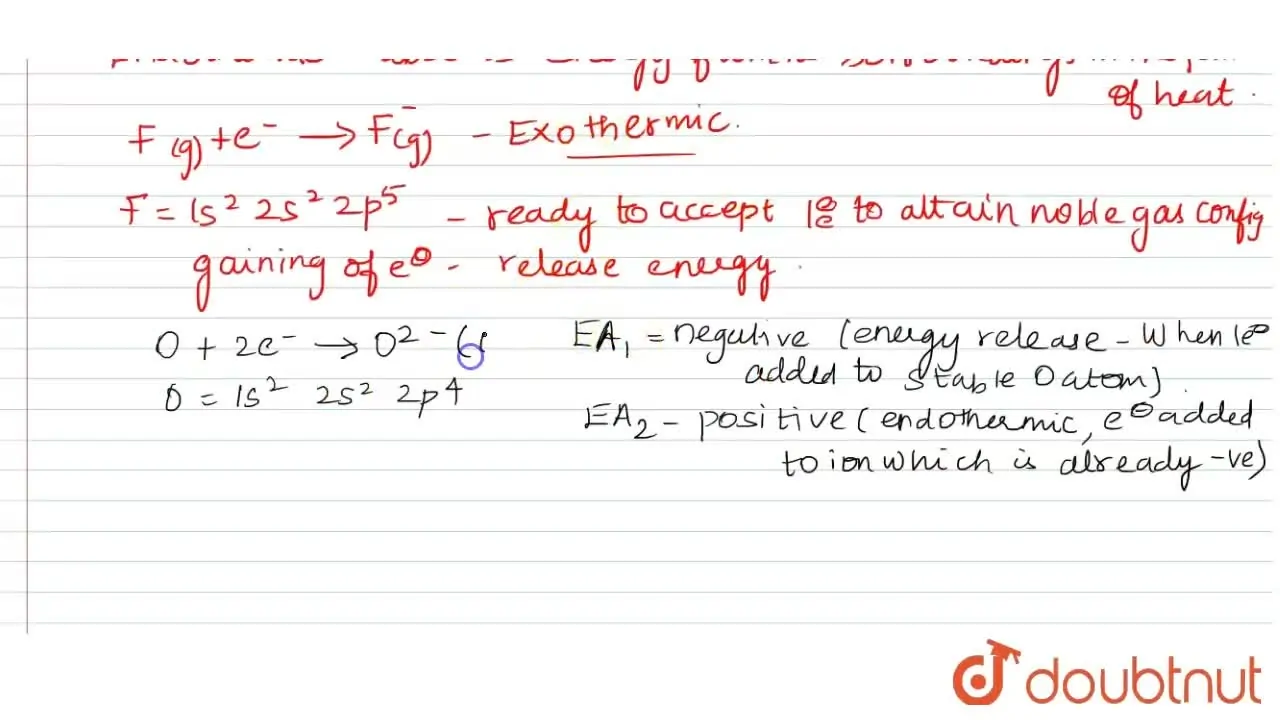Explain the following, give appropriate reasons.
(i) Ionization potential of N is greater than that of O
(ii) First ionization potential of C-atom is greater than that of B-atom, where as the reverse is true for second ionization potential.
(iii) The electron affinity values of Be and Mg are almost zero and those of N (0.02 eV) and P (0.80 eV) are very low
(iv) The formation of . (g) from F(g) is exothermie while that of (g) from O (g) is endothermic.Solution in Tamil
(i) N(Z =7) . It has exactly half filled electronic configuration and it is more stable. Due to stability, ionization energy of nitrogen is high.
. It has incomplete electronic configuration and it requires less ionization energy.
(ii) C(Z=6) . 1. The electron removal from p orbital is very difficult. So carbon has highest first ionization potential.
B . In boron nuclear charge is less than that of carbon, so boron has lowest first ionization potential.
But it is reverse in the case of second ionization energy. Because in case of B the electronic configuration is , which is completely filled and it has high ionization energy. But in C the electronic configuration is , one electron removal is easy so it has low ionization energy.
(iii) Be (Z =4)
Noble gases has the electronic configuration of nsa np. All these are completely filled and are more stable. For all these elements Be, Mg and noble gases, addition of electron is unfavorable and so they have zero electron affinity.
Nitrogen . It has halffilled electronic configuration. So addition of electron is unfavorable and it has very low electron affinity value of 0.02 eV. Phosphorus (Z = 15) . It also has half filled electronic configuration. Due to the symmetry and more stability, it has very low electron affinity value of 0.80 eV.
(iv) exothermic
F (Z = 9) . It is ready to gain one electron to attain the nearest inert gas configuration. By gaining one electron, energy is released, so it is an exothermic reaction.
endothermic
O (Z=8) . It is the small atom with high electron density. The first electron affinity is negative because energy is released in the process of adding one electron to the neutral oxygen atom. Second electron affinity is always endothermic (positive) because the electron is added to an ion which is already negative, therefore it must overcome the repulsion.
Related Playlists
- BOOK - FULL MARKSCHAPTER - PERIODIC CLASSIFICATION OF ELEMENTS EXERCISE - In-Text Question-Evaluate Yourself7videos
PERIODIC CLASSIFICATION OF ELEMENTS
- BOOK - FULL MARKSCHAPTER - PERIODIC CLASSIFICATION OF ELEMENTS EXERCISE - Additional Questions(M.C.Q)38videos
PERIODIC CLASSIFICATION OF ELEMENTS
- BOOK - FULL MARKSCHAPTER - PERIODIC CLASSIFICATION OF ELEMENTS EXERCISE - Textual Evaluation Solved(Choose the correct answer)10videos
PERIODIC CLASSIFICATION OF ELEMENTS
- BOOK - FULL MARKSCHAPTER - HYDROGEN EXERCISE - Additional Questions Solved 5-Mark Questions10videos
HYDROGEN
- BOOK - FULL MARKSCHAPTER - PHYSICAL AND CHEMICAL EQUILIBRIUMEXERCISE - ADDITIONAL QUESTIONS SOLVED (NUMERICAL PROBLEMS)3videos
PHYSICAL AND CHEMICAL EQUILIBRIUM
Similar Questions
What is the basic difference in approach between Mendeleev's periodic table and modern periodic table?
03:14View SolutionThe law of triads is not obeyed by
02:33View SolutionAssertion : Helium has the highest value of ionisation energy among all the elements known
Reason : Helium has the highest value of electron affinity among all the elements known02:40View SolutionExplain about the different industrial preparation of hydrogen.
View SolutionFind the value of Kc for each of the following equilibria from the value of Kp
(a) 2NOCl(g)⇔2NO(g)+Cl2(g),KP=1.8×10−2 atm at 500 K
(b) CaCO3(s)⇔CaO(s)+CO2(g),KP=167 atm at 1073 K05:14View SolutionThe ionization potential for hydrogen atom is 13.6 eV , the ionization potential for He^(+) is
05:14View SolutionThe ionization potential for the electron in the ground state of the hydrogen atom is 13.6 eV "atom"^(-1). What would be the ionization potential for the electron in the first excited state of Li^(+) ?
05:14View SolutionThe first ionization enthalpy of carbon atom is greater than that of boron whereas the reverse it true for the second ionization enthalpy Explain.
03:32View Solutionकिसी तत्व के द्वितीय आयनन विभव का मान प्रथम आयनन विभव से अधिक होता है , क्यों?
03:07View SolutionFirst ionisation potential of C- atom is greater than that of B atom , where as the revers is true is for second ionisation potential.
04:38View SolutionFirst ionisation potential of C- atom is greater than that of B atom , where as the revers is true is for second ionisation potential.
01:37View SolutionFirst ionisation potential of C- atom is greater than that of B atom , where as the revers is true is for second ionisation potential.
04:06View SolutionWhy the first ionisation energy of carbon atom is greater than that of boron atom whereas, the reverse is true for the second ionisation energy.
View SolutionN एवं O परमाणुओं का प्रथम आयनन विभव (eV में ) क्या होगा ?
View SolutionThe first ionization potential (eV) of N and P respectively are
03:05View Solution


